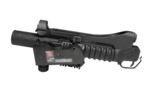Draft:Honduran Army
 | Review waiting, please be patient.
This may take 3 months or more, since drafts are reviewed in no specific order. There are 1,321 pending submissions waiting for review.
Where to get help
How to improve a draft
You can also browse Wikipedia:Featured articles and Wikipedia:Good articles to find examples of Wikipedia's best writing on topics similar to your proposed article. Improving your odds of a speedy review To improve your odds of a faster review, tag your draft with relevant WikiProject tags using the button below. This will let reviewers know a new draft has been submitted in their area of interest. For instance, if you wrote about a female astronomer, you would want to add the Biography, Astronomy, and Women scientists tags. Editor resources
Reviewer tools
|
| This is a draft article. It is a work in progress open to editing by anyone. Please ensure core content policies are met before publishing it as a live Wikipedia article. Find sources: Google (books · news · scholar · free images · WP refs) · FENS · JSTOR · TWL Last edited by Coeusin (talk | contribs) 24 hours ago. (Update)
This draft has been submitted and is currently awaiting review. |
| Honduran Army | |
|---|---|
| Ejército de Honduras | |
 The Honduran Army's emblem | |
| Founded | December 11, 1825 |
| Country | Honduras |
| Type | Army |
| Role | Land warfare |
| Size | 18,000 active (2024) 65,000 reserve (2024) |
| Part of | Armed Forces of Honduras |
| Patron | Our Lady of Suyapa |
| Motto(s) | Honor, Lealtad, Sacrificio ("Honor, Loyalty, Sacrifice") |
| Anniversaries | 3 October (Honduran Soldier Day) 11 December (Honduran Army Day) |
| Engagements | List
|
| Commanders | |
| Commander General of the Armed Forces | |
| Minister of Defence | José Manuel Zelaya Rosales |
| Army Commander | Brigadier General Carlos Efraín Aguilar Hernández |
The Honduran Army is one of the three branches of the Armed Forces of Honduras, as established by the 1982 Constitution. Its recruits are all volunteers.[1]
History
[edit]
The Honduran Army has its roots in the post-independence years, in the early 19th century. In 1831 the first Military School was founded in the San Francisco Barracks, an old nunnery. In the next few decades many wars were fought against the neighbouring countries and also filibusters. In 1895, the army's recruitment guidelines stated that in Honduras there were 18328 active soldiers and 7074 reservists. Reports from the National Congress of Honduras established, however, that in 1896 the country had 34442 men under arms, and between 1897 and 1898 36686 (both in active service and in the reserve), distributed in 67 battalions for the active service, and 22 in the reserve.
In 1909 the Corporals and Sargeants School was created, aiming to organize the army's troops over the Prussian doctrine. Nearly a decade later, in 1917, the National Military School was created to form cadets and officers for the army, based in Toncontin, in Tegucigalpa.
In 1937, a Machine Gun Corps was established (some 22 years after the British Machine Gun Corps had been established, and 15 years after it had been disestablished), and in 1946 the Basic Weapons School was created. In 1949, the Corporals and Sargeants School was reorganized according to the US doctrine. Three years later, the General Francisco Morazán Honduran Military Academy was established in Tegucigalpa.
By the 1980s, the army was made up by circa 30 thousand soldiers, distributed along three infantry brigades, four artillery battalions, an armoured cavalry regiment, an engineer battalion, a logistic support command, infantry schools, paratroopers, communications, and a Combined General Staff with officers from all three branches of the Armed Forces.
Peacekeeping
[edit]The Honduran Army has participated in various humanitarian missions headed by the UN, namely:
The Army also sent a battalion to Iraq during the Iraq War, Tarea Xatruch, which made up part of the Plus Ultra Brigade.
Structure
[edit]- Army General Command
- Army General Staff
- Army Inspector General
- Army Learning Center
- Combat Units
- Combat Support Units
- Combat Support Service Units
Arms
[edit]The Army's units are divided as follows:
- Combat Units
- Infantry
- Cavalry
- Special Forces
- Combat Support Units
- Artillery
- Engineers
- Communications
- Military intelligence
- Combat Support Service Units
- War materiel
- Administration
- Health
- Military justice
- Civilian affairs
Infantry
[edit]The infantry is provisioned with a regulamentation rifle, bayonet, survival equipment, etc., and divided in brigades, which then are divided into battalions, platoons and squads. Though when the army was formed flintlocks were still the standard infantry weapon, soon Remington rifles were adopted, and then M1 Garands. World War II represented a turning point for infantry combat, with the success of American firepower based tactics.[2]

Artillery
[edit]The Artillery is the troop charged with the use of mortars, howitzers, rockets, missiles, etc., in offensive or defensive actions. Nowadays, there are four battalions of artillery in the Honduran Army.
Cavalry
[edit]Around 1750, a Horse Grenadier Corps was created in the province of Honduras by the Spanish colonial authorities, based in the city of Comayagua, though the Honduran Army's cavalry traces its roots to the Morazán Cavalry, a unit raised by President Francisco Morazán in the 19th century, famed for its mobility and performance in battle. The Army's cavalry was expanded from that unit, and maintained its organization until the end of World War I, which demonstrated the limits of traditional cavalry. Soon, armoured cars and tanks were adopted by the country's cavalry.
The Football War, fought in 1969, demonstrated, however, the limitations of the armoured cavalry model adopted by the Army. In 1977, a new model was adopted where the cavalry was reformed, starting to be reorganized into Mechanized Groups, formed mostly by officers and enlisted men taken from infantry units. The first of these was equipped with 12 RBY Mk 1 Israeli light reconnaissance vehicles. Also in 1977 their designation was switched to Reconnaissance Squadrons, and then, finally, in 1981, they were merged into a single Armoured Cavalry Regiment. That year, some tens of British Scorpion, Sultan and Scimitar armoured vehicles were obtained, and construction started and ended on a base for the regiment, located at the Francisco Morazán Department.
In 1983, tensions with Nicaragua made Army command order the regiment's second squadron into the Valle Department; there, it fought skirmishes against the Salvadoran Army, however. In 1984, some of its tanks were handed to infantry units, in order to bolster their capabilities. That same year, 72 Saladin armoured cars were bought from West Germany, allowing the Army to reorganize its Armoured Cavalry into two regiments, with the second being deployed to the Choluteca Department, bordering Nicaragua.[3]
Organization
[edit]- Independent Units:
- Tenth Infantry Battalion
- First Military Engineer Battalions
- Army Logistical Support Command
- 101st Brigade
- Eleventh Infantry Battalion
- Fourth Campaign Artillery Battalion
- First Armoured Cavalry Regiment
- 105th Brigade
- Third Infantry Battalion
- Fourth Infantry Battalion
- Fourteenth Infantry Battalion
- Second Campaign Artillery Battalion
- 110th Brigade
- Sixth Infantry Battalion
- Ninth Infantry Battalion
- First Communications Battalion
- 115th Brigade
- Fifth Infantry Battalion
- Fifteenth Infantry Battalion
- Sixteenth Infantry Battalion
- Army Military Training Center
- 120th Brigade
- Seventh Infantry Battalion
- Twelfth Infantry Battalion
- Special Operations Command
- First Infantry Battalion
- Second Infantry Battalion (Special Tactical Group)
- First Campaign Artillery Battalion
- First Special Forces Battalion

Human rights record
[edit]During the 1980s, especially during the tenure of General Gustavo Álvarez Martínez as head of the armed forces, as the Contra War was fought in Nicaragua, the Honduran Army was responsible for a number of human rights violations, especially its Battalion 3-16, trained and supported by the CIA. Said battalion was a specialized intelligence and counter-intelligence unit, formed by hand-picked officers tasked with profiling and capturing those deemed to be traitors, such as supposed communist infiltrators. Human rights groups have deemed Battalion 3-16 as a death squad, attributing more than 100 civilian deaths to it.[4]
Equipment
[edit]Armored vehicles
[edit]| Name | Image | Type | Origin | Quantity | Status | Notes |
|---|---|---|---|---|---|---|
| FV101 Scorpion | 
|
Light tank | 10 | |||
| RBY Mk 1 | 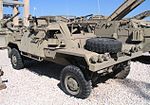
|
Reconnaissance vehicle | 8 | |||
| Alvis Saladin | 
|
Armoured car | 20 | |||
| FV107 Scimitar | 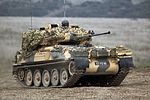
|
Reconnaissance vehicle | 2 | |||
| Black Mamba Sandcat | Infantry mobility vehicle | 5 |
Utility vehicles
[edit]| Name | Image | Type | Origin | Quantity | Notes |
|---|---|---|---|---|---|
| Humvee | 
|
Utility vehicle | 20 | ||
| Ford F-350 | 
|
Pickup truck | 7 | ||
| Jeep J8 | 
|
Utility vehicle | 5 | ||
| M151 | 
|
Utility vehicle | 15 | ||
| M151A1C | 
|
Utility vehicle | 12 | ||
| Trucks | |||||
| Mercedes-Benz L series 4x4 | 
|
Truck | |||
| Unimog | 
|
Truck | 12 | ||
| M 35 | 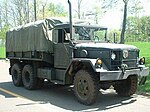
|
Truck | 14 | ||
| Ashok Leyland Stallion | 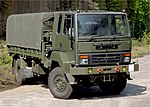
|
Truck | 19 | ||
| Ashok Leyland Topchi | 
|
Truck | 14 | ||
Artillery
[edit]| Name | Image | Type | Origin | Quantity | Notes |
|---|---|---|---|---|---|
| M101 howitzer | 
|
Howitzer | 4 | ||
| M102 howitzer | 
|
Howitzer | 12 | ||
| M198 howitzer | 
|
Howitzer | 12 | ||
| Soltam M-66 | 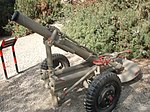
|
Mortar | 10 | ||
| Soltam K6 | 
|
Mortar | 12 | ||
| FM-81 | Mortar | 11 |
Anti-tank weapons
[edit]| Name | Image | Type | Origin | Caliber | Notes |
|---|---|---|---|---|---|
| M72 LAW | 
|
Rocket-propelled grenade launcher | 66mm | ||
| Carl Gustav M2 | 
|
Recoilless rifle | 84mm | ||
| RPG-7 | 
|
Rocket-propelled grenade launcher | 40mm |
Air defence systems
[edit]| Name | Image | Type | Origin | Quantity | Notes |
|---|---|---|---|---|---|
| TCM-20 | 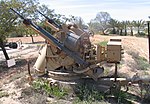
|
Autocannon | 14 | 20mm autocannon | |
| M55A2 | Autocannon | 12 | 20mm autocannon |
Small arms
[edit]Military academies
[edit]General Francisco Morazán Honduran Military Academy
[edit]Named after the President of Honduras and Central America Francisco Morazán, this academy's purpose was to substitute the old Military Academy, which dated from the 19th century. It is located in the Francisco Morazán Department.[5]
Armed forces military training schools
[edit]- Honduran Warrant Officers School
- Artillery School
- Communications School
References
[edit]- ^ "Honduras". cia.gov. Retrieved 15 September 2024.
- ^ "Historia del Ejército en Honduras". ffaa.mil.hn. Retrieved 18 September 2024.
- ^ "La Caballería Blindada del Ejército de Honduras". defensa.com. Retrieved 18 September 2024.
- ^ "Copia archivada". Archived from the original on 17 October 2011. Retrieved 11 November 2011.
- ^ "Academia Militar de Honduras General Francisco Morazán". acamildehon-gralfcomorazan.es.tl. Retrieved 18 September 2024.




















